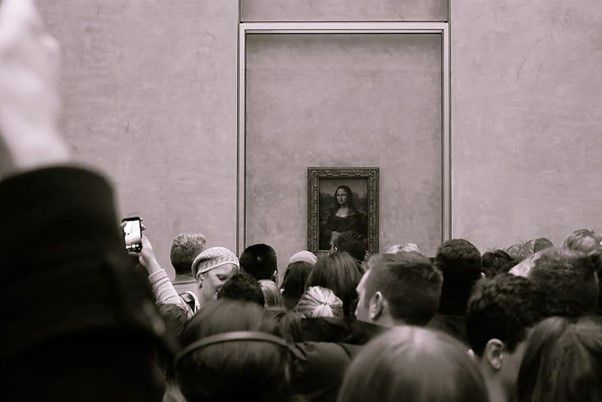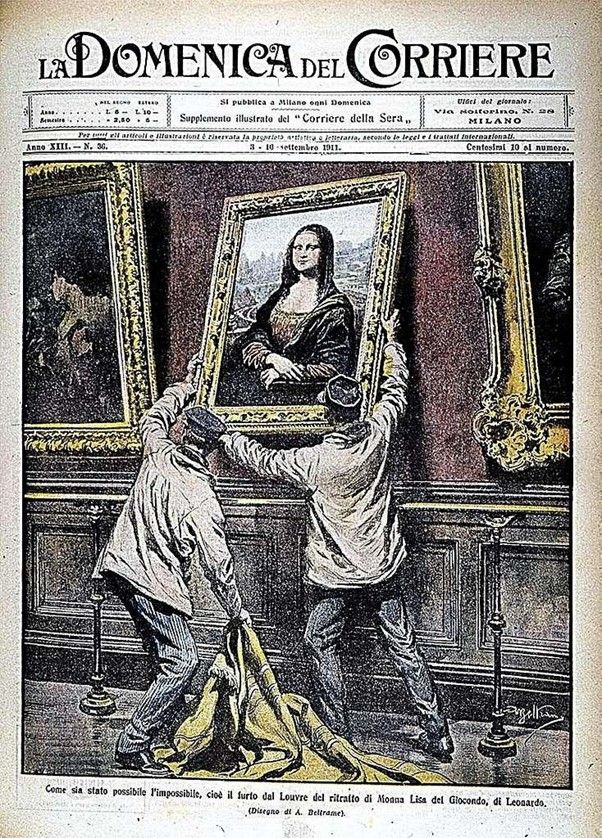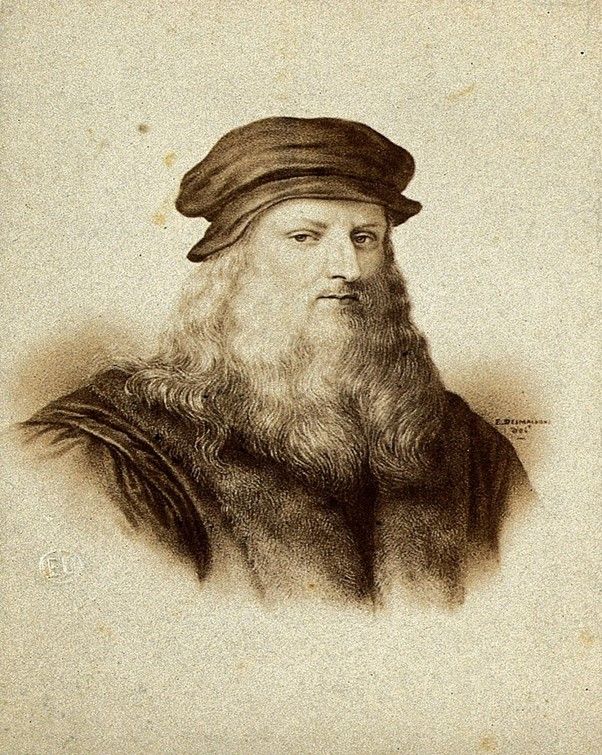Da Vinci’s Mona Lisa and Her Smile: The Painting, the Painter, and the Muse
The most popular artist in history, Leonardo da Vinci, was a polymath. But the world primarily knows him for painting the Mona Lisa. The piece of art shining in the Louvre museum never got the recognition that it deserved during his lifespan. The story of the Mona Lisa itself is quite intriguing as much as the story of her smile — it is the only painting that got lost to get famous.

Spectators in front of the Mona Lisa portrait at Louvre Museum, Paris. Image source: Wallpaper Flare.
The aesthetic selfies that we click and post with quotes from Hemingway or Sylvia Plath always have the faintest of smiles — that ‘Mona Lisa’ smile, which is neither a laugh nor a smirk, is the centre of any and all conversation around the painting. Not many know the origin of the woman in the portrait and the idea behind the painting and its popularity.
Mona Lisa was born to Antomaria di Noldo Gherardini in 1479. This was a time when Italy was undergoing a Renaissance. There were large changes in the political, economic and social structure of the country. The city of Florence was the hub of all change. Mona Lisa’s father earned his income from his fields and farmlands located in the vicinity of the town of Florence. He had properties in the countryside but had to reside in rented accommodation in the quarters of S. Spirito. This was because their house in the city got damaged and was unsafe for any kind of habitation.
Moreover, Antomaria did not have any means to restore his damaged property. What might fascinate a reader is that this piece of information has been obtained by historians from land revenue records, which contain details of taxes paid by Antomaria during his service period.
At the beginning of March 1495, Lisa Gherardini’s marriage ceremony was solemnised. Mona Lisa Gherardini was married off to Francesco di Bartolomeo di Zanobi del Giocondo and she became Mona Lisa Del Giocondo. Antomaria Gherardini paid a dowry for his daughter’s marriage. This included a piece of farmland near his countryside home and 170 large gold florins. Since the amount of dowry was not large, it can be assumed that Francesco gained nothing from this marriage. He perhaps married Mona Lisa for sole affection, which can also be proved by his decision to have his beloved wife painted by none other than the great painter Leonardo da Vinci.
The smile of the Mona Lisa is eye captivating. It will feel like she is smiling back at the onlooker. Some also believe that every time the eyes move along with the smile. This is her speciality. Da Vinci used mathematics, anatomy, optics, and art to create this portrait and mastered his attempt to make Mona Lisa’s smile feel real.
Francesco di Bartolomeo di Zanobi del Giocondo, an Italian businessman, was born in 1460 and belonged to a well-known silk and cloth merchant family. It is believed that he held various business opportunities and public offices in Florence till the second decade of the 16th century. Mona Lisa was his third wife, whom he married in 1495. But this piece of information remains vague as the authenticity has not yet been proved by the biographer Vasari, who provided this part of the information in “Le Monnier.”
The world-famous painting is attributed to one of the greatest painters in the history of mankind, Leonardo da Vinci. The Italy-born da Vinci was commissioned by kings and the high nobility for his assistance in their varied projects. This made him travel a lot. He was commissioned to Florence many times, which was the hub of all liberal arts during those times.
Detectives were commissioned to search for the painting. US business tycoons like J.P. Morgan and famous painter Pablo Picasso were also interrogated regarding the theft. The growing tension around World War II suggested that this could be the act of the Germans. Almost two years later, the thieves tried to sell the painting, which was world-famous by that time, and therefore, the thieves were caught. Mona Lisa returned to her old glass frame.
During World War II, the painting of the Mona Lisa and many other great pieces of art were hidden from the Nazi army. The paintings travelled from castle to castle and were hidden in the safest possible places. The portrait of the Mona Lisa finally returned to the Louvre after the war ended.
The Grande Galleria of the Louvre hosts the largest number of tourists, for it is the permanent home of the Mona Lisa. The portrait jewelled by the red velvet background between two marble columns faces the portrait of King Francis I, the first actual owner of the painting itself.
From various accounts of biographers, it is assumed that da Vinci began painting the Mona Lisa during his second visit to Florence, which lasted from 1500 to 1506. It can be easily assumed that he gave all his time and attention to his project of portraying the Mona Lisa. But, in reality, he was working there as an engineer and architect for other projects. He was so busy with work during this time that Isabella d’Este (a famous figure during the Italian Renaissance) kept on pestering him for her portrait, but to no avail.
The situation, however, changed in 1503. Da Vinci’s state-supported projects got over during this time. He was left in Florence with no work. He had to pay for his residence and stay. This might be one reason why he took up the project of painting the Mona Lisa. Interestingly, no records of the painting being ordered and receipt of payment regarding the painting of Mona Lisa has been found so far. Da Vinci apparently never delivered the painting.
The records of Francesco di Bartolomeo di Zanobi del Giocondo, who might have commissioned da Vinci to paint his beloved Mona Lisa, must have had a motive behind it. In 1502, Mona Lisa gave birth to her second son. This was a matter to celebrate for the entire family. Childbirth was the biggest cause of death for women during those days. Francesco had lost both his wives due to this and Mona Lisa being alive after delivering her child was indeed a matter of joy.
The same blessedness was probably not shared by Mona Lisa herself. Mona Lisa lost her first child in 1499. This is why many art historians refer to the veil of mourning that she adorns in the portrait. The colour of her dress in the painting is black, which also might refer to her being in mourning.
The 30-inch-long portrait of Mona Lisa was purchased by the French king Francis I for 4000 gold ducats. There is a probability that this purchase was done after the death of da Vinci. It is commonly believed that the painting ornamented the walls of the Chateau de Cloux near Amboise along with other painted marvels of Leonardo da Vinci. The Mona Lisa resided at the Fontainebleau Palace in 1550 and was later taken to Versailles. Its last ride was in 1706, when it was finally taken to Louvre.
The painting has never left its premises except during two unusual circumstances. In 1911, three men took the pains of removing the Mona Lisa from its glass case, removed the frame, wrapped it with a blanket and swiftly made away with the painting. The theft at the Louvre Museum made the painting world-famous. Before that, it was one of the least-known paintings of da Vinci, talked about only among artists who would simply appreciate the painter’s strokes.

The news of the stolen portrait of Mona Lisa remained the cover story of all newspapers during that time. Image source: Picryl.

A sketch of Leonardo da Vinci. Image Source: Wikimedia Commons.


